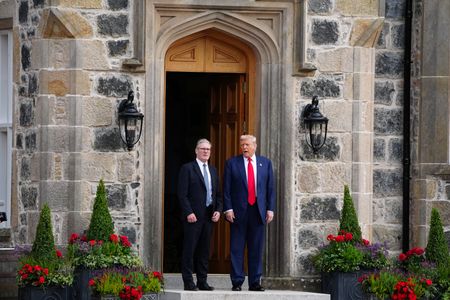By Philip Blenkinsop
BRUSSELS (Reuters) – European Commission President Ursula von der Leyen said on Tuesday that the European Union had a “strong plan” to retaliate against tariffs imposed by U.S. President Donald Trump, although it preferred a negotiated solution.
The Trump administration put in place tariffs on imported steel and aluminium in March and higher duties on cars will take effect on Thursday. Trump will set out plans for measures he calls “reciprocal tariffs” on Wednesday.
The United States and European Union have the world’s largest commercial relationship, trading 1.6 trillion euros ($1.7 trillion) of goods and services in 2023, almost 30% of global trade.
In a war of tariffs on goods, Washington would have more to target than Brussels, as U.S. goods imports into the EU totalled 334 billion euros in 2024, against 532 billion euros of EU exports, according to EU statistics agency Eurostat.
Here is a look at the possible EU responses.
RETALIATORY TARIFFS
The European Commission can propose retaliatory tariffs on goods, which can be blocked only by a qualified majority of 15 EU member states representing 65% of the EU population.
It has already outlined a two-stage planned response to the steel and aluminium tariffs. First, it says it will restore measures introduced in 2018 when Trump first imposed tariffs on imports of the metals, later suspended under Joe Biden. These counter-measures, including a 50% tariff on U.S. bourbon, were due to come into force on Tuesday, but the Commission later delayed them until mid-April to allow more time to consider which U.S. goods to hit.
Wine exporters France and Italy have expressed concern about taxing bourbon after Trump threatened to retaliate with 200% tariffs on European alcohol.
The Commission also drew up another list of U.S. imports, including meat, dairy produce, wines and clothing, valued at 21 billion euros, which it planned to narrow down to 18 billion euros, for a second tranche of tariffs, originally due to be applied from mid-April.
The EU has not yet said what steps it would take in response to the automobile tariffs or the upcoming reciprocal levies.
ANTI-COERCION INSTRUMENT
The EU’s Anti-Coercion Instrument (ACI), which came into force at the end of 2023, allows the bloc to retaliate against third countries that put economic pressure on EU members to change their policies, and offers far wider scope for action.
As well as imposing goods tariffs, the EU can limit access to public procurement tenders for companies from a third country or take action affecting services trade or investment.
While the United States has a trade deficit with the EU in goods, it has a surplus in services trade, including digital services provided by the likes of Amazon, Microsoft, Netflix or Uber.
The EU can also restrict protection of intellectual property rights, limit financial service companies’ access to EU markets and curb companies’ ability to place chemicals and agri-food products in the EU.
The ACI was proposed in 2021 as a response to EU member criticism that the first Trump administration and China had used trade as a political tool. China had targeted Lithuania, according to Lithuanian officials, after it allowed Taiwan to set up a de facto embassy in Vilnius.
The law gives the Commission up to four months to examine possible cases of coercion. If it finds a foreign country’s measures constitute coercion, it proposes this to EU members, which have another eight to 10 weeks to confirm the finding.
For this, a qualified majority of EU members is required, a higher bar to pass than for applying retaliatory tariffs.
The Commission would normally then consult with the foreign country to stop the coercion. If that fails, then within six months it can adopt EU response measures, which would enter force within three months.
The whole process could take a year.
($1 = 0.9275 euros)
(Reporting by Philip Blenkinsop; Additional reporting by Leigh Thomas in Paris; Editing by Peter Graff)











